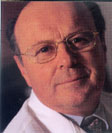 (continued) “This
allows patients and their caregivers to take advantage of opportunites
for transcendency,” Meyers says. “The end of life can
be a time of remarkable emotional and spiritual growth. We see people
healing damaged relationships, bringing their lives to a close in
ways that not only bring them peace but also bring comfort to the
family, leaving loved ones with lessons they can carry with them
through future generations, until the end of their own lives.”
Home |
Table of Contents |
To our Readers |
Building on Basics UC Davis Health System | © 2000, 2001, 2002 UC Regents. All rights reserved. |
|

 Fred
Meyers is an early pioneer of the hospice movement.
Fred
Meyers is an early pioneer of the hospice movement.